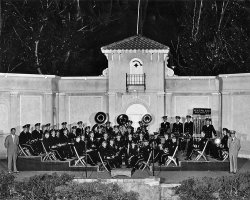
MAY CONTAIN NUTS

Search Shorpy
SHORPY ART

Framed or unframed, desk size to sofa size, printed by us in Arizona and Alabama since 2007. Explore now.
Join and Share
Ad-Free Shorpy
Shorpy is funded by you. Patreon contributors get an ad-free experience.
Learn more.

Recent comments
- Freeze Frame
- Texas Flyer wanted
- Just a Year Too Soon
- WWII -- Replacing men with women at the railroad crossing.
- Yes, Icing
- You kids drive me nuts!
- NOT An Easy Job
- I wonder
- Just add window boxes
- Icing Platform?
- Indiana Harbor Belt abides
- Freezing haze
- Corrections (for those who care)
- C&NW at Nelson
- Fallen Flags
- A dangerous job made worse
- Water Stop
- Passenger trains have right of way over freights?
- Coal
- Never ceases to amaze me.
- Still chuggin' (in model form)
- Great shot
- Westerly Breeze
- For the men, a trapeze
- Tickled
- Sense of loneliness ...
- 2 cents
- Charm City
- What an Outrage
- Brighton Park
Member Photos
The Shorpy
Print Emporium
Print Emporium
Search Shorpy
Search results -- 30 results per page
- Come Fly With Me: 1952
- ... Ava is buried at Sunset Memorial Park in Smithfield, North Carolina. We'll be driving through there early next week on our way to points ... Posted by Dave - 10/26/2019 - 6:12pm -
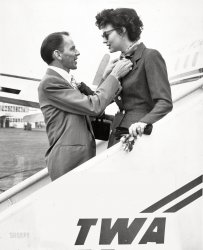
- Sign of the Cross: 1940
- ... and a glass of milk) at the railroad crossing at Camden, North Carolina." Medium format acetate negative by Jack Delano for the Farm Security ... Posted by Dave - 04/30/2021 - 1:23pm -
![Sign of the Cross: 1940 July 1940. "Negroes from Florida and Georgia who travel by car and truck, following the potato crop northward. Migratory agricultural worker has his supper (a nickel pie and a glass of milk) at the railroad crossing at Camden, North Carolina." Medium format acetate negative by Jack Delano for the Farm Security Administration. View full size.
Pie the wayThe young fellow in the foreground looks as if he's posing for an advertisement. His pose, his face, the pie and the milk - - they combine to look as if they are tempting the viewer to indulge, although I'm unsure if the ad would be for milk or pie. By the way, that's a generous slice of pie for a nickel.
[A "nickel pie" is an entire small pie, not a slice. - Dave]
Locomotive TireThat heavy ring protecting the crossing signal is a worn out steam locomotive tire.
Locomotive tires were heated with a circular gas burner to expand them, then shrunk onto the cast driver center. They tended to wear to a hollow tread contour rather than the correct slightly conical surface, which should have a specific fillet radius to the flange. Every time a locomotive spun its wheels, the tires were wearing out of contour.
The tires could be turned a couple times, like brake disks or brake drums, but then were discarded to be melted down. This one escaped the furnace, and makes a nice seat, although usually too hot or too cold.
Also interesting how little grade crossing signals have changed in 81 years.
Model railroaders, take note!
(The Gallery, Agriculture, Jack Delano, Railroads)](https://www.shorpy.com/files/images/SHORPY-8c02723a.thumbnail.jpg)
- Shoofly Tobacco: 1939
- July 1939. Shoofly, North Carolina. "Tobacco field in early morning where white sharecropper and wage ... Posted by Dave - 02/06/2008 - 10:32pm -

- Nate Greene: 1918
- ... of General Nathanael Greene in my hometown of Greensboro, North Carolina (named for General Greene). The image of Greene on his horse has been ... Posted by Dave - 09/11/2011 - 8:54pm -
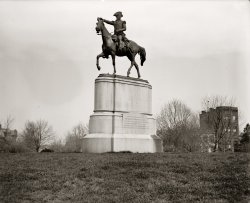
- Johnnie and His Friend: 1908
- ... Tallest boy Johnnie Younts, 72 Kirk Street, Salisbury, North Carolina. Has worked at in Salisbury Mills for 8 years. Began at 7 years old. ... Posted by Dave - 12/14/2007 - 2:19am -
![Johnnie and His Friend: 1908 Tallest boy Johnnie Younts, 72 Kirk Street, Salisbury, North Carolina. Has worked at in Salisbury Mills for 8 years. Began at 7 years old. When can he get any education? Other boy one year in mill. December 1908. Photograph by Lewis Wickes Hine. View full size. [At least they could afford nice clothes - Dave]
JohnnieI dare say we're educating children for 13+ years now only to discover they don't have the basic skills...like reading and math. We've missed the boat somehow.
Not wrong, Johnnie! TheNot wrong, Johnnie! The Commies said they'd do it.
My grandmother & her sistersMy grandmother & her sisters only went to school to about the 6th grade. One sister was very smart, so she was skipped up a grade in school. My mom says that was about all the education girls were given then (early 1900s) unless they planned to teach school. Usually if you taught school, you only taught until you married or shortly after marriage as schools wouldn't employ a visibly pregnant woman. My grandmother and one sister died before I was born, but I remember her other sister Essie (the smart one) who could read and write as well as anyone I know.
(The Gallery, Lewis Hine, Railroads)](https://www.shorpy.com/files/images/01514u_0_0.thumbnail.jpg)
- Monster Mash: 1936
- ... Creek recreational demonstration area near Raleigh, North Carolina." This old-timer is leveraging his assets. Photo by Carl Mydans for ... Posted by Dave - 06/04/2013 - 6:09am -
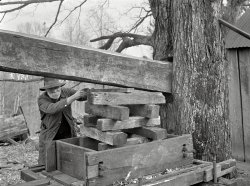
- Drink a Bite to Eat: 1938
- April 1938. Store in Halifax, North Carolina, with signs advertising carbonated beverages and patent medicines. ... Posted by Dave - 12/28/2007 - 1:55pm -
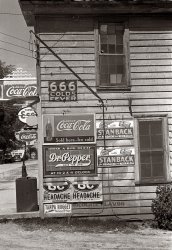
- Portrait of Caroline: 1939
- ... this week, in the doorway of her kitchen in Orange County, North Carolina. View full size. Medium-format nitrate negative by Dorothea Lange ... Posted by Dave - 09/09/2011 - 11:49am -
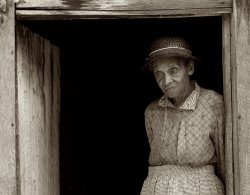
- Home Office: 1938
- 1938. "Smith Furnace, office, Lincoln County, North Carolina." A relic of the charcoal-iron industry, with its forges and furnaces, ... Posted by Dave - 07/12/2014 - 1:41pm -
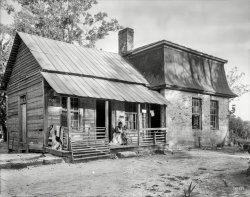
- Crime Museum: 1941
- ... an old, shell-shocked World War veteran. Near Fort Bragg, North Carolina." Acetate negative by Jack Delano. View full size.
Outlaws ... Posted by Dave - 11/28/2018 - 7:08pm -
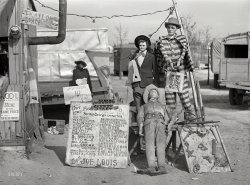
- Boys With Brooms: 1908
- November 1908. "Some Sweepers in a North Carolina cotton mill." Photograph by Lewis Wickes Hine for the National Child ... Posted by Dave - 08/15/2012 - 9:50am -
![Boys With Brooms: 1908 November 1908. "Some Sweepers in a North Carolina cotton mill." Photograph by Lewis Wickes Hine for the National Child Labor Committee. View full size.
DistractionsLewis Hine must have had an assistant with him for all his group shots -- there are always a few people looking to the photographer's right (especially the women in groups). Having started out as an assistant "holding the light," I had to keep quiet so as not to attract someone's eyes!
[Or it might have been Hine himself. - Dave]
(The Gallery, Factories, Lewis Hine)](https://www.shorpy.com/files/images/01400u.thumbnail.jpg)
- Avenue of Oaks: 1938
- ... trees, Mount Pleasant vicinity, Charleston County, South Carolina." 8x10 negative by Frances Benjamin Johnston. View full size.
... mentioned above, the hugely popular mini series "North & South" was filmed at Boone Hall as well as "Queen", an Alex Haley ... Posted by Dave - 02/08/2014 - 11:39am -
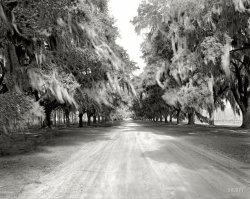
- Bare Beach: 1939
- ... truck to go to market, from small truck farm of man from North Carolina. Near Belle Glade, Florida." Bare Beach was an agricultural outpost on ... Posted by Dave - 07/18/2014 - 2:44pm -
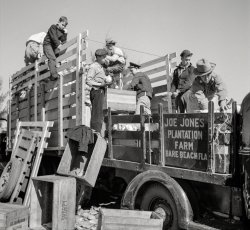
- Warping Boy: 1908
- ... "Boy at warping machine, Catawba Cotton Mill. Newton, North Carolina." Glass negative by Lewis Wickes Hine. View full size.
... Posted by Dave - 04/26/2014 - 1:24pm -
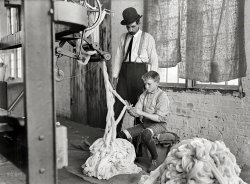
- A Drink for Baby: 1943
- ... putting water in his radiator along U.S. Highway 29 in North Carolina en route to Charlotte." Medium format negative by John Vachon for the ... Posted by Dave - 08/31/2017 - 7:45pm -
![A Drink for Baby: 1943 March 1943. "Melvin Cash, truck driver, putting water in his radiator along U.S. Highway 29 in North Carolina en route to Charlotte." Medium format negative by John Vachon for the Office of War Information. View full size.
Easy Peasy Nice and EasyI'll take the jacket, the hat and the water bucket. I'd take the truck too but parking could be a challenge. I love SHORPY -- it never fails to deliver.
Truck IDBrown; in house make of Associated Transport.
[The tractor is a circa 1938 Corbitt in Horton Trucking livery. Some of these were rebadged as Browns after Horton entered into the Associated Transport merger. - Dave]
Sealed beam conversion?Hayslip, looking at the size of the headlight buckets versus the headlights, I'm wondering if it has been fitted with a sealed beam conversion. One big advantage that came with the advent of sealed beams was that the lamps were a universal 7-inch size that would fit anything. It was much easier to replace the lamp after it burned out, and replacing one after taking a hit from a stone meant you didn't have to try to find parts specific to your vehicle - especially important for over-the-road trucks.
The REAL movers and shakersThis comment may seem off-topic, but I'd like to acknowledge all the truckers and railroad workers that often provided a bright spot to the day for many youngsters, me included, at least in the 1940's and 50's since we walked everywhere including to school, church, movies, the park, etc. It was such a kick for a kid to see a big rig coming down the road and know that if he just put up his arm and pretended to pull a rope, that the congenial trucker would blast on his air horn just for us. Likewise, if a train was passing by and we could see the engineer or the caboose man, they would wave and blow their whistle and make one feel important. Yes, I was a sometimes lonely, small town kid, usually walking alone everywhere, but these men made me feel like I had some influence in the world. It was a feeling of mutual respect on both sides and I salute and thank them all for taking the time to acknowledge the requests of all the powerless children everywhere who enjoyed immensely causing the instant reaction from the vehicle's operator. I know the work of truckers and railroaders is grueling and often taken for granted but they made the day for many kids and brought everything people needed to remote villages and towns across the country and they still do. Thanks guys.
(The Gallery, Cars, Trucks, Buses, John Vachon)](https://www.shorpy.com/files/images/SHORPY-8d27720a.thumbnail.jpg)
- Stinson 10A: 1943
- ... an old friend that flew his Fairchild 24 off the coast of North Carolina until one day his engine quit at sea and he was later picked up by a ... Posted by Dave - 12/10/2007 - 6:13am -
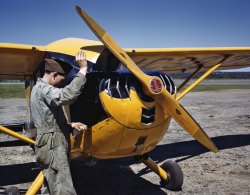
- Got a Light?
- July 1939. Person County, North Carolina. A tobacco curing barn ready for "putting in," with fuel stacked on ... Posted by Dave - 01/20/2008 - 2:01am -
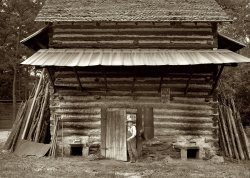
- Store Noir: 1940
- May 1940. "Corner store at 11 p.m. Durham, North Carolina." Medium format negative by Jack Delano for the Farm Security ... Posted by Dave - 11/06/2018 - 4:12pm -
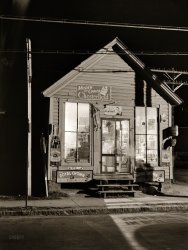
- Remain Calm: 1943
- July 1943. "Greenville, South Carolina. Men of the medical unit of the 25th Service Group simulating the ... on 1 May 1943, at Marine Corps Base Camp Lejeune, North Carolina and was initially manned by Marines from throughout the Northeast. ... Posted by Dave - 06/09/2018 - 1:47pm -
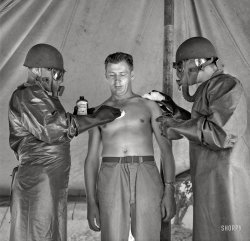
- Testing Their Wings: 1902
- Kitty Hawk, North Carolina. "Start of a glide; Wilbur in motion at left holding one end of glider ... Posted by Dave - 12/14/2007 - 9:16pm -
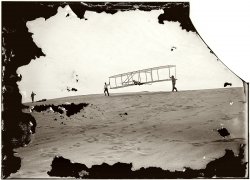
- Bonus Points: 1928
- ... of girl archers at the Grove Park Inn, Asheville, North Carolina." Gelatin silver print. View full size.
Still there, still ... Posted by Dave - 06/27/2020 - 7:06pm -
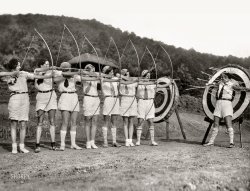
- New River: 1942
- May 1942. Marine transport driver at New River, North Carolina. View full size. 4x5 Kodachrome transparency by Alfred Palmer, ... Posted by Dave - 07/24/2012 - 9:37pm -
![New River: 1942 May 1942. Marine transport driver at New River, North Carolina. View full size. 4x5 Kodachrome transparency by Alfred Palmer, Office of War Information.
Dog tagsIs it possible to blow up the dog tags on the Marine on the left enough to get a name or serial number off of them?
[Not much to see. - Dave]
(The Gallery, Kodachromes, Alfred Palmer, Cars, Trucks, Buses, WW2)](https://www.shorpy.com/files/images/1a35185u.thumbnail.jpg)
- Le Petit Theatre: 1937
- ... books resulted from this venture, "Early Architecture of North Carolina" and "Early Architecture of Georgia." In 1945 she was awarded an ... Posted by Dave - 08/14/2012 - 3:52pm -
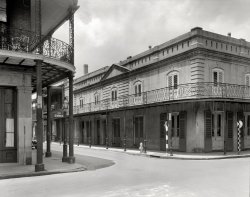
- Loray Mill: 1908
- November 1908. Gastonia, North Carolina. "Going home from Loray Mill. Smallest boy on the right-hand end, John ... Posted by Dave - 08/15/2012 - 9:51am -
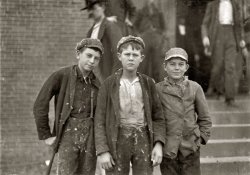
- Horsefeathers: 1923
- ... Snuffy Smith 11 years later Barney and the horse go to North Carolina mountains and meet moonshiner Snuffy Smith.
And thanks to this ... Posted by Dave - 09/11/2011 - 7:03pm -
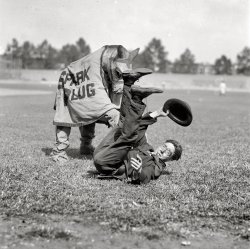
- Social Climber: 1941
- March 1941. "Boy from North Carolina. Family has just moved to Newport News, Virginia, for work in ... Posted by Dave - 01/22/2020 - 7:35am -
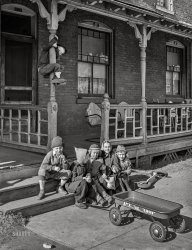
- Bi-Biplane: 1917
- ... the pilot, a fellow named Manley. A few days later, in North Carolina, the Wright brothers successfully tested their aircraft, virtually ... Posted by Dave - 10/01/2013 - 5:48pm -
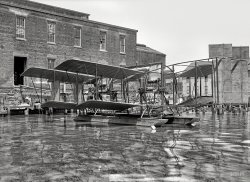
- Doffer & Spooler: 1908
- December 1908. Newton, North Carolina. "Catawba Cotton Mill doffer and spooler." Glass negative by Lewis ... Posted by Dave - 07/31/2016 - 12:41am -
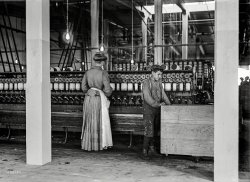
- Full House: 1938
- 1938. "Andrews Log House, Rutherford County, North Carolina. Norwell, tenant." 8x10 inch acetate negative by Frances Benjamin ... Posted by Dave - 08/07/2017 - 9:47am -
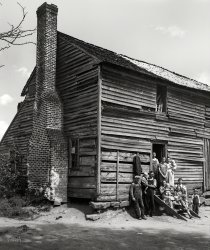
- Sioux Falls Municipal Band
- ... , from his youth in New Hampshire to his final days in North Carolina. But someplace in the middle, he and my grandmother spent a number of ... Posted by k2 - 09/20/2011 - 1:29am -
